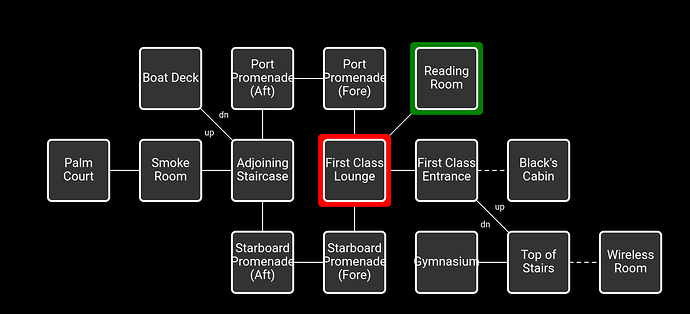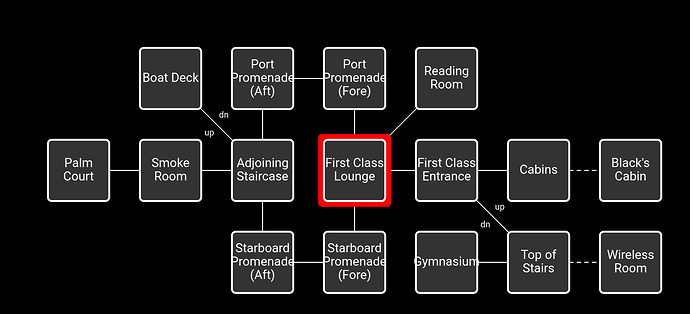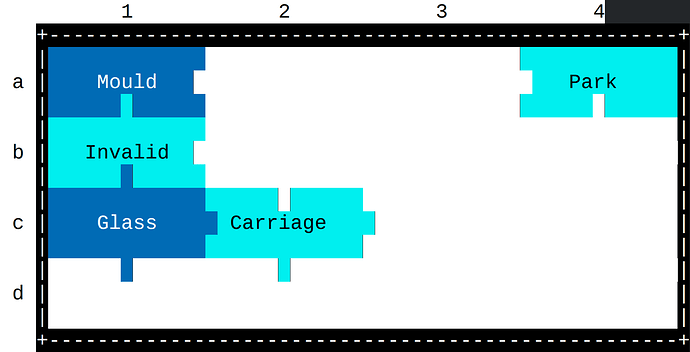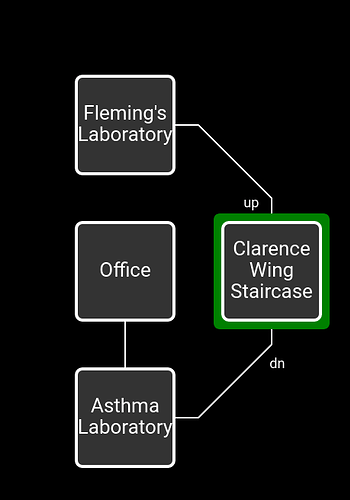Oh, true, if Shutes survived then she must have left the séance at some point, right?
Let’s see what happens if we go back after handling everything else. (We do discover that the jacket doesn’t protect us from the wireless operator: he still takes the key and throws us out.)
At 12:31 am, we’ve gotten one piece, picked up the KD, gotten the towel (though I’m not sure we need it), worn the jacket, collected the seasickness medicine, and sent out a distress signal. But the poker game and the séance are still going. Nothing to do now but…wait, I guess?
>z
Time passes.
“The air tonight,” remarks Miss Shutes to her companions, “reminds me of the ice-caves of the Eiger. Shall I ever stop shivering!” They simper in concurrence.
Dum de dum.
>z
Time passes.
The cardplayers speculate amiably about the size of the iceberg. “Eighty feet above deck, would you say, Colonel?”
Dum de dum.
>z
Time passes.
“I say,” says Guggenheim, “d’you think there’s ice up on deck? I could do with a jolt,” and he waves his whisky to a great uproar of laughter.
Dum de dum.
>z
Time passes.
Dum de dum.
>z
Time passes.
Guggenheim suddenly seizes you by the braided arm of your uniform jacket. “Look, officer,” he says confidentially and urgently, “I can see how things are going. Bad. This -” he pushes a letter of some kind into your hand - “this letter must, must be delivered, or… I can’t tell you. But you’ll be on one of the boats if anything happens. Dammit, it’s of the utmost importance!”
Wait, what?
Okay, so if we’re in the smoke room in uniform at 12:43, then suddenly things get urgent?
>ask guggenheim about letter
“Say, what kind of an officer are you? I’m sworn to secrecy.”
A new response!
>x letter
A letter marked “Secret and Confidential - Deliver via courier” and sealed up with wax for good measure, addressed to the U.S. Secretary of State.
Sealed, you say?
>save
Ok.
>open letter
Consider your honour and duty as a subject of the British Empire!
Oh right, this is still Imperial times. But would a subject of the British Empire really think they have any duty to those upstart American colonies or the gauche noveau riche who inhabit them? If they wanted to be treated with honour, they should have acted with honour, I say! Now bring me my tea!
Well, anyway, the game won’t let us. So I guess we have to just take the letter with us when we get on the lifeboats, and…
Wait. Shit. We’re not getting on the lifeboats.
But, thanks to Wikipedia, we know someone who is!
>show letter to shutes
“Crikey! Hush-hush stuff!”
Yes, exactly!
>give letter to shutes
Her mouth makes a perfect O of astonishment, then her eyes widen and she gasps. “Crikey!” she exclaims. Then she tucks it into the cleavage of her dress, where (astonishingly) it is concealed away. “It’s safe with me.”
She scampers away, and the ouija school disbands, theatrically looking round for spies at every corner.
[Your score has just gone up by two points.]
Okay, so this is why the Titanic was a turning point in world history—it would have been so easy for Guggenheim’s letter to get lost. This is why sending the distress signal is enough to avoid wrecking history: Guggenheim gave the letter to another officer, who was rescued by the Carpathia and got it back to the States. But handling things this way means we can also take…
>x board
You can’t see any such thing.
>x ouija
You can’t see any such thing.
Huh?
You can see a corner piece here.
Oh, the name changed on us.
>get corner
(putting the elegant key into the canvas rucksack to make room)
Taken.
[Your score has just gone up by one point.]
We can also get this!
This one is also six inches on a side, so a very small ouija board. Or maybe they were using this as a planchette, and the board itself was an unrelated gray square object.
Anyway, I think we’re safe now. All we have to do is get in the time window and we’re home free!
>tell guggenheim about shutes
This provokes no reaction.
>tell guggenheim about letter
This provokes no reaction.
Stoic as ever.
We make it back to the lounge at 1am, giving us just over an hour to play around. I was going to set the clock back to 59, but we could also just…
>turn off alarm
The latch on the clock is now off.
Now we wait a long time, and…
From inside the rucksack, the ormolu clock makes a rustle-click.
It doesn’t take us away, so we can make it to the Land!
Wait an even longer time, and…
The air here suddenly seems disturbed, and a kind of cloud gathers from light winds and currents.
From inside the rucksack, you hear a bell ring.
You are utterly terrified. There’s only one chance left: the time window!
Run!
>press white button
The cloud of disturbed air condenses into a kind of spherical ink-black ball, large enough to swallow you up whole.
And we’re back inside the sphere. Moving doesn’t actually seem to be what gets us out—rather, we take any two actions and then it drops us in the Land.
Now that we’ve solved this place, we can explore a bit more here, maybe?
>s
Thick Mist
Thick, cloudy mist covers the Land here, suspended in the air like milk in water.
Huh.
Going north from where we enter the Land also drops us in the mist, and we can’t go west. I suspect we’re on the puzzle board—we’re at position c1, on the west edge of the board, and the pieces north and south of us (b1 and d1) haven’t been placed. But c2 has, which is why we can go east, and find the pyramid right at the center of this place.
A bit of experimentation confirms that we can move through the mist, though we can’t see anything, and any path that takes us to the center will bring us back to the Disc Room.
Now, the question—have we wrecked history?
>list
a4 parklands strobed by laser light (solved)
c1 a cocktail in a glass, with tonic and ice (solved)
c2 a horse-drawn state carriage (solved)
No we have not!
>footnote c1
[ Footnote c1: ]
The interior layout is simplified from the Midsummer 1911 issue of “The Shipbuilder” magazine, and events and dialogue from the more reliable survivors’ accounts. Most of the stories about the Titanic are myths, from inaccurate press reports and the four films made over the years. The crew and owners behaved honourably throughout, the provision for lifeboats was not as poor as usually said, and there was almost icy calm amongst the passengers not allowed into the boats.
The iceberg was not large and the collision mild: but in those temperatures, the steel hull was only roughly as strong as a tin can.
The S.S. Carpathia arrived after the Titanic went down at 2.20 am, but rescued 711 of the 2206 aboard. Of those who appear in the game, only Miss Shutes and the wireless operator survived. Mr Guggenheim changed into a dinner jacket, “to die a gentleman”. The Captain and the Titanic’s designer refused to try for the lifeboats.
Just before the end, the wireless operator sent the first SOS signal ever heard at sea. The band played ragtime (not hymns) to the end.
That lines up with what I’ve read. So the wireless operator we met must have been the junior one, Harold Bride, because the senior one, Jack Phillips, went down with the ship (sending messages to the very end, even after the electricity had failed).
A few weeks ago I came across this video showing the internal layout of the Titanic, if you don’t feel like poking through The Shipbuilder. The map in Jigsaw is remarkably accurate to the first-class section of the ship—and in the video you can see why there’s the one “southwest” connection when everything else uses cardinal directions!
I’ll make another post later today, looking at our new puzzle pieces and where they might take us. But one last thing first:
>restore
Ok.
>set clock to 1
You shorten the time left on the clock.
Suddenly you are wrenched out into the time vortex once more, and find yourself back…
For whatever reason, leaving with the letter doesn’t wreck history. I suppose because we still have time to go back and give it to Shutes?
But no, even if we wait until the last minute before leaving, keeping the letter doesn’t wreck history. Only failing to send the distress signal does. I suspect this is a bug. (Also, disappointingly, even if we take the letter to the far future where both Guggenheim and his correspondent are long dead, our “honour” still prevents us from opening it. Anyone have any idea what this letter might have been?)
Side note: Wikipedia tells me that Guggenheim helped his mistress, Léontine Aubart, and her maid, Emma Sägesser, onto the lifeboats before changing into formalwear to “die like a gentleman”. If he sent the letter with us rather than them, he presumably wanted to entrust it to an officer rather than a random passenger, and wouldn’t have been happy with us sending it to Shutes. But it got us two points, and that’s what really matters, right?
Save file and transcript:
05.sav (1.6 KB)
05b.txt (36.5 KB)
No changes to the map this time, thankfully!




